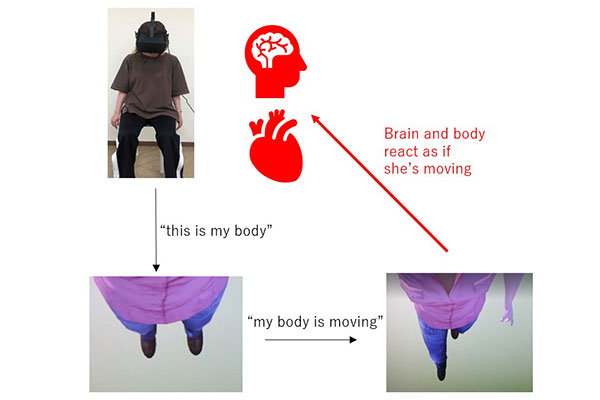Sep 1 2020
At the Smart-Aging Research Center (IDAC) of Tohoku University, scientists have designed a novel training protocol that uses immersive virtual reality (IVR) to achieve real cognitive and physical benefits.
 A schematic theoretical interpretation of the virtual illusion, leading to measurable physiological effects on the person’s body. Image Credit: © Tohoku University.
A schematic theoretical interpretation of the virtual illusion, leading to measurable physiological effects on the person’s body. Image Credit: © Tohoku University.
All individuals are aware that physical exercise is essential for the general well-being and helps delay aging-related disorders; a more fascinating aspect is that physical exercise is beneficial not just for the body but also for cognitive functions.
Sadly, it is not always possible to perform physical activities for individuals who have been suffering or recovering from long-term diseases.
This problem can be overcome by using IVR, which enables the formation of a realistic virtual world that can be explored with the virtual body.
Although this concept sounds imaginary, the illusion is so powerful that even when the person is sitting and the virtual body is walking, the individual thinks he or she is moving—it even produces similar physiological reactions.
Professor Ryuta Kawashima, director of IDAC, guided the research team to find out whether virtual training can have comparable benefits on cognitive functions as physical exercise. Young and healthy participants took up a virtual training protocol. They wore an IVR headset while sitting and observed a virtual body (also known as an avatar) shown in the first-person point of view. This led to the imaginary feeling of being the avatar itself. The virtual body switched from 30 seconds of walking to 30 seconds of running for 8 minutes.
The team observed that the heart rate of the participants shot up steadily with the virtual movements, although the subjects were entirely still. More significantly, testing of cognitive functions (particularly, executive functions) and their neural basis was performed before and after the virtual training.
The findings revealed that participants enhanced their cognitive performance (in particular, they were faster), as also established by the increase in activation of the brain-related areas (the left dorsolateral prefrontal cortex in particular).
The application of immersive virtual reality for clinical purposes is often doubted because it was originally designed for entertainment. But this study proves that training protocols in IVR can be useful for people with motor impairments to have comparable benefits to real physical activity. It is also beneficial for people who want to start exercising in an entertaining and safe way.
Dalila Burin, Professor, Tokohu University
This experiment was designed and carried out by Professor Burin. Through the introduction of virtual reality technology in the field of cognitive neuroscience, the team intends to offer clinical solutions for patients and also help develop theoretical models of motor control and body representation.

The virtual body as experienced by the user. Video Credit: © Tohoku University.
Journal Reference:
Burin, D., et al. (2020) Virtual training leads to physical, cognitive and neural benefits in healthy adults. NeuroImage. doi.org/10.1016/j.neuroimage.2020.117297.